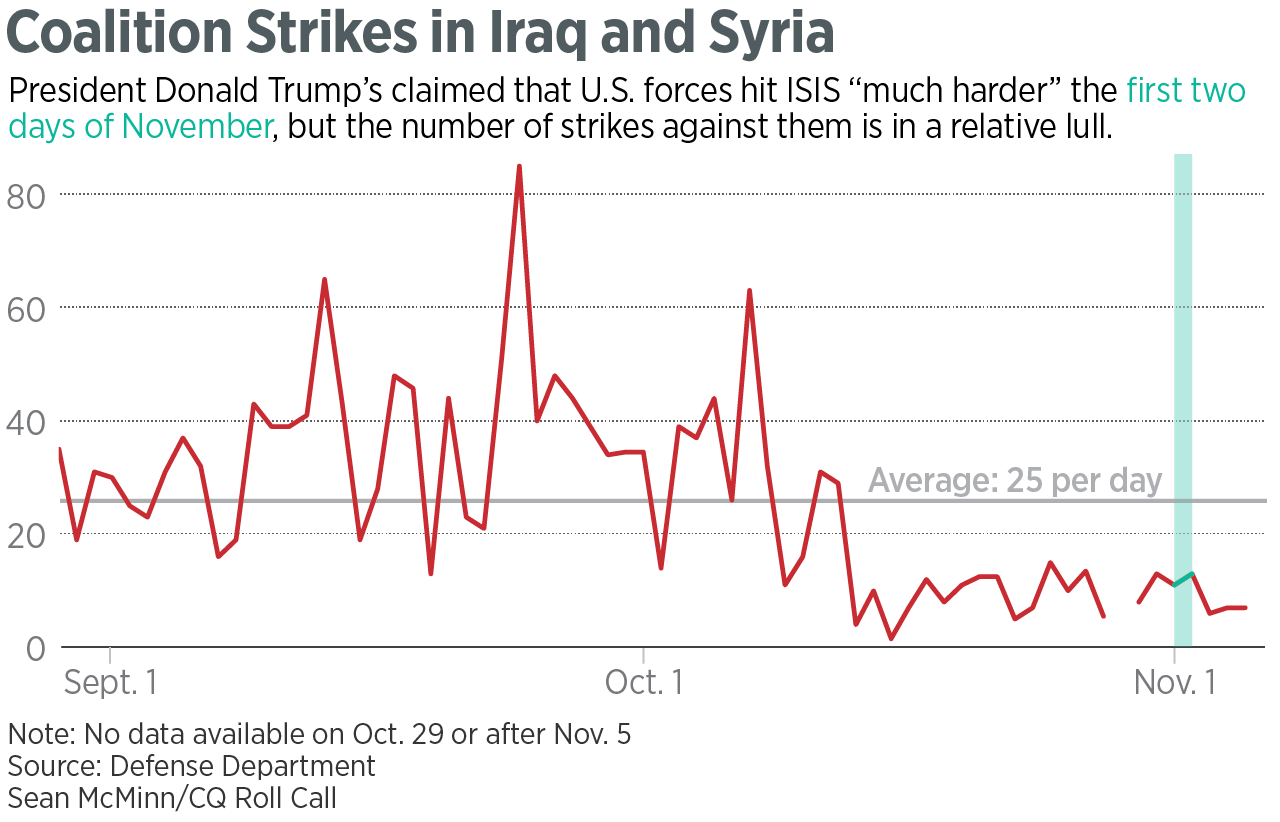Fact-Checking Trump’s Claim on U.S. Attacking ISIS ‘Much Harder’
As the terrorist group loses ground, there are fewer targets to attack

U.S. and coalition strikes against the Islamic State terrorist group have fallen dramatically in the last month, despite President Donald Trump’s assertion last week that the military had hit the group “much harder” in response to a terrorist attack in New York City.
On Nov. 1 and 2, the days on which Trump said the military had stepped up attacks against ISIS, coalition forces launched 24 strikes in Iraq and Syria. That is less than half the two-day strike average for coalition forces since March 31, according to a Roll Call analysis of Defense Department news releases.
On Tuesday, Oct. 31, a man who expressed support for ISIS killed eight people by driving down a bike path in Manhattan. Days later, the president, in a Twitter post, promised retaliatory measures against the terrorist group.
“ISIS just claimed the Degenerate Animal who killed, and so badly wounded, the wonderful people on the West Side, was ‘their soldier,’” Trump tweeted on Friday, Nov. 3. “Based on that, the Military has hit ISIS ‘much harder’ over the last two days. They will pay a big price for every attack on us!”
Trump later told reporters that “every time we are attacked from this point forward … we are hitting them 10 times harder.”
The strike count alone does not necessarily prove the veracity — or lack thereof — of Trump’s statement that ISIS was hit harder after the Halloween attack in Manhattan. The Pentagon does not make public how many aircraft or weapons it uses in a single strike, and certain other assaults, such as ground-based artillery used to help with troop movements, do not count as a strike.
But judging at least by the number of airstrikes, the military did not hit the group harder in the two days Trump referenced, according to official statistics.

On the first of those two days, coalition forces launched 11 strikes — fewer than they had the day before. On the second day, they launched 13, with the majority aimed at targets in Syria.
The White House did not respond by publication time to a request for comment on these findings.
‘Relentless pursuit’
Asked at a news conference to reconcile the president’s comments with the low strike count, Brig. Gen. Andrew A. Croft, the highest ranking Air Force officer in Iraq, said Trump was referring to the “relentless pursuit of ISIS wherever they are.”
“We need to steel ourselves against declaring victory and walking away,” Croft said. “So that means a relentless pursuit of these folks, so that we destroy their leadership and their command and control here, so that it doesn’t spread out of these areas, to other areas.”
The low number of strikes at the beginning of November came after a month of reduced activity from the air. Croft said strikes dropped by about 60 percent to 70 percent in October, compared to monthly averages for the rest of the year.
Trump has said he intends to be more aggressive in his tactics in fighting ISIS and to give commanders more leeway to make battlefield decisions. But as his 10 months in office have progressed, the anti-ISIS coalition has largely reduced its bombing strikes, officers say, because the targets are dwindling as insurgents are killed or flee.
John M. Donnelly contributed to this report.





